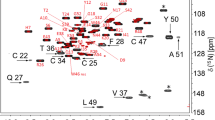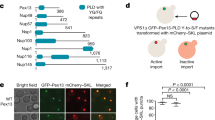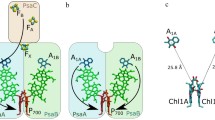Abstract
The internal pH of peroxisomes in the yeasts Hansenula polymorpha, Candida utilis and Trichosporon cutaneum X4 was estimated by 31P nuclear magnetic resonance (NMR) spectroscopy. 31P NMR spectra of suspensions of intact cells of these yeasts, grown under conditions of extensive peroxisomal proliferation, displayed two prominent Pi-peaks at different chemical shift positions. In control cells grown on glucose, which contain very few peroxisomes, only a single peak was observed. This latter peak, which was detected under all growth conditions, was assigned to cytosolic Pi at pH 7.1. The additional peak present in spectra of peroxisome-containing cells, reflected Pi at a considerably lower pH of approximately 5.8–6.0. Experiments with the protonophore carbonyl cyanide m-chlorophenylhydrazon (CCCP) and the ionophores valinomycin and nigericin revealed that separation of the two Pi-peaks was caused by a pH-gradient across a membrane separating the two pools. Experiments with chloroquine confirmed the acidic nature of one of these pools. In a number of transfer experiments with the yeast H. polymorpha it was shown that the relative intensity of the Pi-signal at the low pH-position was correlated to the peroxisomal volume fraction. These results strongly suggest that this peak has to be assigned to Pi in peroxisomes, which therefore are acidic in nature. The presence of peroxisome-associated Pi was confirmed cytochemically.
Similar content being viewed by others
Abbreviations
- CCCP:
-
Carbonyl cyanide m-chlorophenylhydrazon
- DCCD:
-
N,N′-dicyclohexylcarbodiimide
References
Douma AC, Veenhuis M, Koning W de, Evers M, Harder W (1985) Dihydroxyacetone synthase is localized in the peroxisomal matrix of methanol-grown Hansenula polymorpha. Arch Microbiol 143:237–243
Douma AC, Veenhuis M, Sulter GJ, Harder W (1987) A proton-translocating adenosine triphosphatase is associated with the peroxisomal membrane of yeasts. Arch Microbiol 147:42–47
Goodman JM, Scott CW, Donahue PN, Atherton JP (1984) Alcohol oxidase assembles post-translationally into the peroxisome of Candida boidinii. J Biol Chem 259:8485–8493
Hofer M, Nicolay K, Robillard GT (1985) The electrochemical H+-gradient in the yeast Rhodotorula glutinis. J Bioenerg Biomembr 17:175–182
Lenz A-G, Holzer H (1984) Effects of chloroquine on proteolytic processes and energy metabolism in yeast. Arch Microbiol 137:104–108
Nicolay K, Scheffers WA, Bruinenberg PM, Kaptein R (1982) Phosphorus-31 nuclear magnetic resonance studies of intracellular pH, phosphate compartmentation and phosphate transport in yeast. Arch Microbiol 133:83–89
Nicolay K, Scheffers WA, Bruinenberg PM, Kaptein R (1983) In vivo 31P NMR studies on the role of the vacuole in phosphate metabolism in yeasts. Arch Microbiol 134:270–275
Veenhuis M, Harder W (1987) Yeast microbodies. Their substructure, biogenesis and turnover in relation to environmental conditions. In: Rose AH (ed) The yeasts, vol 3. Academic Press, London
Veenhuis M, Keizer I, Harder W (1979) Characterization of peroxisomes in glucose-grown Hansenula polymorpha and their development after transfer of cells into methanol-containing media. Arch Microbiol 120:167–175
Veenhuis M, Dijken JP van, Harder W (1980) A new method for the cytochemical demonstration of phosphatase activities in yeasts based on the use of cerous ions. FEMS Microbiol Lett 9:285–291
Veenhuis M, Douma A, Harder W, Osumi M (1983) Degradation and turnover of peroxisomes in the yeast Hansenula polymorpha induced by selective inactivation of peroxisomal enzymes. Arch Microbiol 134:193–203
Veenhuis M, Hoogkamer-Te Niet MC, Middelhoven W (1986) Biogenesis and metabolic significance of microbodies in urate-utilizing yeasts. Antonie van Leeuwenhoek 51:33–43
Veenhuis M, Klei IJ van der, Harder W (1986) Physiological role of microbodies in the yeast Trichosporon cutaneum during growth on ethylamine as the source of the energy, carbon and nitrogen. Arch Microbiol 145:39–50
Zwart KB, Veenhuis M, Plat G, Harder W (1983) Characterization of glyoxysomes in yeasts and their transformation into peroxisomes in response to changes in environmental conditions. Arch Microbiol 136:26–38
Author information
Authors and Affiliations
Rights and permissions
About this article
Cite this article
Nicolay, K., Veenhuis, M., Douma, A.C. et al. A 31P NMR study of the internal pH of yeast peroxisomes. Arch. Microbiol. 147, 37–41 (1987). https://doi.org/10.1007/BF00492902
Received:
Accepted:
Issue Date:
DOI: https://doi.org/10.1007/BF00492902




